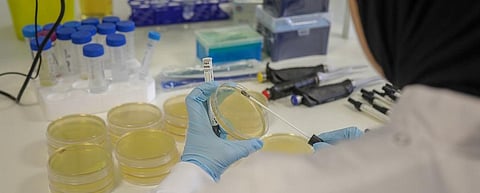

Amid mounting concerns that antimicrobial resistance (AMR) — a global public health threat and a chronic pandemic — will be exacerbated by the novel coronavirus disease (COVID-19) pandemic, a group of researchers have designed software program to identify antimicrobial resistant bacteria.
They did so by applying game theory — an approach that deploys study of mathematical models of strategic interaction among game players.
The team from Washington State University developed the software tool, Prediction of Antimicrobial Resistance via Game Theory (PARGT), that comes with a simple graphic-user interface and can run on operating systems such as Windows, Linux, etc. The findings were published in journal Scientific Reports on July 6, 2020.
A global threat
Antimicrobial resistance happens when microorganisms such as bacteria, fungi, viruses and parasites become less vulnerable to antimicrobial drugs such as antibiotics. The microbes develop drug resistance mechanisms, thereby making it difficult to treat infectious diseases such as tuberculosis, pneumonia, etc.
At least 2.8 million people in the United States get infected every year by antimicrobial-resistant organisms, according to a recent report by the Centers for Disease Control and Prevention (CDC). These infections result in more than 35,000 deaths every year, the report stated.
The problem is expected to worsen in future decades in terms of increased infections, deaths and health costs as bacteria evolve to “outsmart” a limited number of antibiotic treatments, according to the report.
The software
“We need to develop tools to easily and efficiently predict antimicrobial resistance that increasingly threatens livelihoods around the world,” said Chowdhury, lead author of the paper.
The model deployed machine learning to predict antimicrobial resistant genes. Unlike the conventional method that involves DNA sequencing, machine learning models detect features that are unique to antimicrobial resistant genes.
Using their machine learning algorithm and game-theory approach, the researchers looked at the interactions of several features of the genetic material in drug-resistant microbes.
In their earlier work, the researchers had found that game-theory feature was capable of identifying the most relevant, non-redundant features necessary for accurate prediction of about 93-99 per cent gram-negative bacteria, according to a study published by the same group of researchers on July 3.
Gram-negative bacteria are resistant to multiple drugs and are resistant to most available antibiotics.
In the recent research, the scientists applied the tool to gram-positive bacteria and introduced software for identifying antimicrobial-resistance genes for both gram-positive and gram-negative bacteria.
The team considered resistance genes found in species of Clostridium, Enterococcus, Staphylococcus, Streptococcus, and Listeria — all gram-positive bacteria. They are known to cause several infectious diseases such as staph infections, food poisoning and pneumonia.
During the research, scientists were able to accurately classify resistant genes with up to 90 per cent accuracy.
According to Shira L Broschat, co-author of the paper, “You can bootstrap and improve the software as more positive data becomes available.”
PARGT can be used with the Windows, Linux, or macOS and other operating systems.